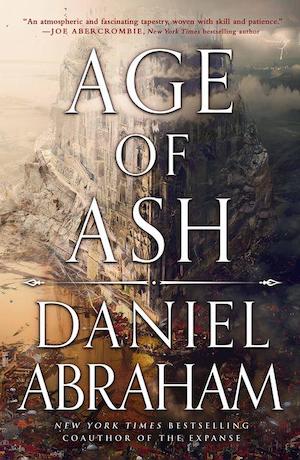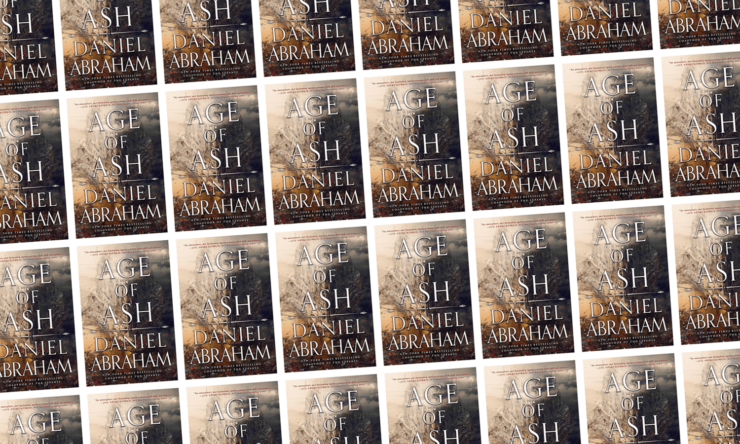There are books in which settings are like characters, and then there’s Age of Ash. Daniel Abraham’s new fantasy novel is set in the city of Kithamar, which for three hundred years “has been a free city, independent and proud and ruled by princes of its own rather than any distant king.”
Kithamar is full of slums and wealthy merchants’ houses, street rats and elegant priests. It’s home to two races who disagree on many things, including the history of the city. It’s also home to something stranger and darker and more mysterious—something Abraham shows but doesn’t explain in this book, the first novel of a trilogy. Age of Ash keeps its boots on the ground, tracing the streets of Kithamar primarily through the lives of those who might know them best: Alys and Sammish, a pair of street rats from the slums of Longhill, whose stories go a bit sideways when one of their pulls goes wrong.
I didn’t quite know what to expect from Age of Ash. The cover copy is a little vague, the reviews were a little vague, and the title gives very little away. I’ve read all of Abraham’s work as half of James S.A. Corey, but not his previous fantasy novels (an error in judgment that I certainly plan to correct). What I got is the kind of intimate fantasy I’m always looking for—the kind that builds from the ground up and unspools in a world that’s layered and rich and full of nuance; the kind that remembers that the stories of the street kids struggling to find a warm bed are just as compelling as stories set in polished halls among the ruling elite. Everyone has a place in Kithamar’s ecosystem, from the butchers to the highborn, the merchants to the brewers, the guardsmen to the child-minders. A city takes all kinds in order to work—and this one has more kinds than most.
Buy the Book


Age of Ash
Abraham casts a wide net, and draws in a complex, nuanced tangle of characters with few outright heroes or villains (and some absolute mysteries). His world feels familiar: The people in power have bought into a system that benefits them more than others, but ultimately serves something else entirely. Power is concentrated, and not exactly where even the rulers think it is.
Alys, though, doesn’t care about any of that. She cares about her brother, Darro, who meets an untimely end after he comes to her rescue when one of her pulls (pickpocket scams, basically) goes awry. Undone with grief, Alys is desperate to understand what happened. What she finds in his rooms—money, a strange knife, an even stranger candle—brings her into the orbit of the Daris Brotherhood, a religious order (one of many in Kithamar) whose rites and beliefs are deeply woven into the fabric of the city’s ruling class.
Sammish, who has a knack for being unnoticed, cares about Alys, and takes her own path to understanding what happened to Darro, and what it’s done to her friend’s life. She’s easier to be around; she goes poking around quietly, meets unexpected people, curls up at night behind a baker’s house with a neighborhood cat on her feet. You want good things for Sammish, who has a dream of a steady job and a cozy home—things that are so far from her experience that she’s almost uncomfortable with wanting them. “Something about wanting it that badly felt like crime,” she thinks.
Alys is much pricklier, and I love her for it. Abraham doesn’t go out of his way to put obstacles in front of his characters; they were born with obstacles on all sides, whether Alys’s poor, depressed mother or the simple fact of where she was raised. Her anger and guilt and grief turn her into a different version of herself, one who wears different clothes and hangs out in different parts of the city; she walls herself off, trying to become harder and colder, trying to live the life she imagined Darro led. But imaginations are faulty things, especially when grief is involved.
Alongside Alys’s quest, and Sammish on her heels, is the mystery of what happened to Kithamar’s dead prince, Bryn a Sal, whose unsteady reign is mostly unseen yet central to Age of Ash’s wider vision. Abraham has said that the three books in this series take place over the same time period, each focusing on different characters. In the details and the pauses, the secrets and the smoke, you can see just how the city’s tale is bigger than what Alys and Sammish understand—but that doesn’t make their part in it any less compelling.
This is a slow burn but not a slow book. It’s the kind of telling that wants to be savored, each chapter a new layer in how the reader understands the world through which the characters move. They aren’t defined by their roles or positions in life, but by how they live, how they choose: What the lady Andomaka does with her power, what Sammish does when she loses one paltry source of income. There are different kinds of need, and Abraham traces needs and choices and risks through the city’s filthy streets until he shows how desperation might lead a poor girl and an ancient being to a crossroads. (There’s a well-kept secret in Kithamar, one that suggests a sort of twisted mirror-image to a concept N.K. Jemisin works with in The City We Became—but to say more would be both spoilery and difficult; there’s much more to learn as this series continues.)
If you are, like I was, an Expanse fan wondering if you ought to start reading Abraham’s solo work, the answer I’d give is a resounding yes. There are some thematic overlaps—Kithamar is full of ordinary people trying to live with and around strange powers—but it’s Abraham’s sharp eye for details, and for just the right kind of details, that feels familiar, and that makes this novel sing. He knows what his characters would see or notice in a given scene, from the sediment at the bottom of a beer glass to the tiny shifts that signal the arrival of spring, and he knows when to step back a little and set the broader scene for us, to give the reader the tools to conjure our own versions of this fantastic city. He’s neither flowery nor economical as a writer, but considered and wise; this is the kind of prose that reads as if it came effortlessly. Age of Ash is at once immersive and intimate, a story about grief that’s also a story about how the world works. It’s going to be a long wait for volume two.
Age of Ash is available from Orbit.
Molly Templeton lives and writes in Oregon, and spends as much time as possible in the woods. Sometimes she talks about books on Twitter.










